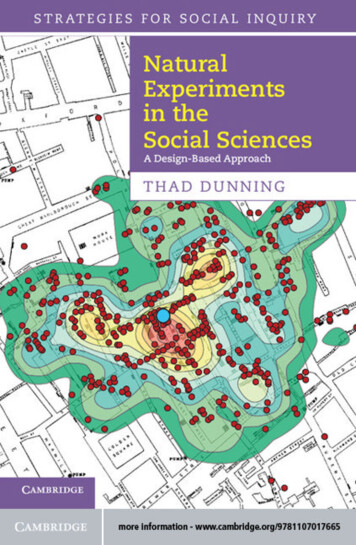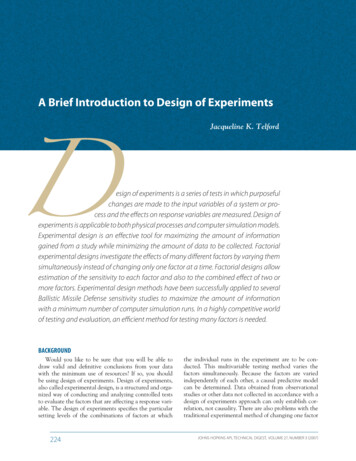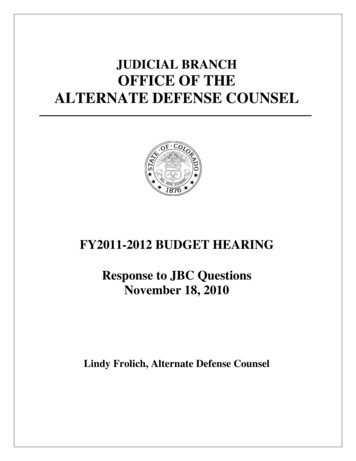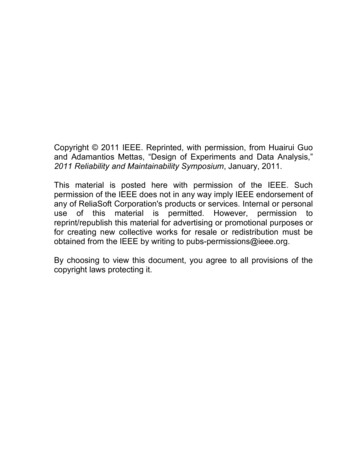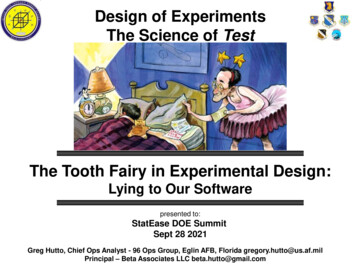
Transcription
Quality Engineering, 24:60–79, 2012Copyright # Taylor & Francis Group, LLCISSN: 0898-2112 print 1532-4222 onlineDOI: 10.1080/08982112.2012.627288Designed Experiments for the DefenseCommunityRachel T. Johnson1,Gregory T. Hutto2,James R. Simpson2,Douglas C. Montgomery31Naval Postgraduate School,Monterey, California2Eglin Air Force Base, Eglin,Florida3Arizona State University,Tempe, ArizonaABSTRACT The areas of application for design of experiments principleshave evolved, mimicking the growth of U.S. industries over the last century,from agriculture to manufacturing to chemical and process industries to theservices and government sectors. In addition, statistically based quality programs adopted by businesses morphed from total quality management toSix Sigma and, most recently, statistical engineering (see Hoerl and Snee2010). The good news about these transformations is that each evolution contains more technical substance, embedding the methodologies as core competencies, and is less of a ‘‘program.’’ Design of experiments is fundamental tostatistical engineering and is receiving increased attention within large government agencies such as the National Aeronautics and Space Administration(NASA) and the Department of Defense. Because test policy is intended toshape test programs, numerous test agencies have experimented with policywording since about 2001. The Director of Operational Test & Evaluation hasrecently (2010) published guidelines to mold test programs into a sequence ofwell-designed and statistically defensible experiments. Specifically, the guidelines require, for the first time, that test programs report statistical power asone proof of sound test design. This article presents the underlying tenentsof design of experiments, as applied in the Department of Defense, focusingon factorial, fractional factorial, and response surface design and analyses. Theconcepts of statistical modeling and sequential experimentation are alsoemphasized. Military applications are presented for testing and evaluationof weapon system acquisition, including force-on-force tactics, weaponsemployment and maritime search, identification, and intercept.KEYWORDS factorial design, optimal design, power, response surface methodology, space filling design, test and evaluationAddress correspondence to Rachel T.Johnson, 1411 Cunningham Rd.,Naval Postgraduate School, GlasgowHall–Rm 253, Monterey, CA 93943.E-mail: rtjohnso@nps.eduWHY DOES THE DEFENSE COMMUNITY NEEDDESIGN OF EXPERIMENTS?Any organization serious about testing should embrace methods and ageneral strategy that will cover the range of product employment, extractthe most information in limited trials, and identify parameters affecting60
performance. For example, the purpose of Air Force(AF) test and evaluation (T&E) is ‘‘mature systemdesigns, manage risks, identify and help resolve deficiencies as early as possible, and ensure systems areoperationally mission capable (i.e., effective and suitable)’’ (AF TE 2009, p. 1). Similar instructions andregulations guide the other U.S. armed services.The fields of designed experiments and industrialstatistics, with their rich histories spanning over acentury, provide the framework for test scienceexcellence. Large-scale efforts are underway in theDepartment of Defense (DoD) to replace current teststrategies of budget-only-driven test events, combatscenarios, changing one factor at a time, and preserving traditional test programs with a scientific andstatistically rigorous approach to test—design ofexperiments. Design of experiments improves DoDtest rigor by objectively justifying the number of trialsconducted based on decision risk, well apportioningtest conditions in the battle space, guiding theexecution order to control nuisance variation, andobjectively separating the signal of true systemresponses from underlying noise.Effectiveness and efficiency are essential to all testing but especially military test and evaluation. Thefootprint of the military T&E enterprise is substantial,whether measured in resources, people, or nationaldefense capacity. The DoD spent nearly 75 billionin research, development, test, and evaluation in fiscal year 2008. To illustrate the scope in one service,AF T&E accounts for an estimated 25–30% of all11,000 AF scientists and engineers; in expenditures,AF research, development, test, and evaluation was 26.7 billion—20% of the U.S. Air Force (USAF) budget (Secretary of the Air Force Financial ManagementOffice [SAF FM] 2007). Design of experiments (DOE)enables effectiveness of system discovery withdetailed process decomposition tying test objectivesto performance measures, together with test matricesthat span the operating region and allow for faults tobe traced to causes. Efficiencies are gained by combining highly efficient screening designs with initialanalyses to learn early, followed by knowledgebased test augmentation for continued learning viastatistical modeling, culminating in validationtests—all with the purpose of full system understanding using only the resources necessary. The DoD ismoving toward the use of DOE as the primarymethod of test. As stated in the guidance document61(2010), published by the Director of Operational Testand Evaluation, there is a specific request to‘‘increase the use of both scientific and statisticalmethods to in developing rigorous, defensible testplans and in evaluating their results’’ (p. 1). Theseguidelines require test programs not to explicitly‘‘do DOE’’ but to report the evidences of welldesignedexperimentsincludingcontinuousresponse variables, how test factors are to be controlled during test, and the strategy (family of testdesigns) used to place individual points in the spaceto be explored. This article supports the reshaping ofthe DoD T&E policy by detailing basic experimentaldesign tools and their application in military context.Military T&E is serious business, because it dictatesthe future effectiveness of U.S. defense forces. Testprograms designed using the principles of designedexperiments stand to improve the cost-effectivenessof defense acquisition by ensuring that experimentation and failures occur during development andnot in the field; that correct decisions are reachedin fielding new combat capability; and that only theappropriate amount is expended during test in anera of declining defense budgets.BACKGROUND AND HISTORY OFDESIGNED EXPERIMENTSStatistically designed experiments are among themost useful, powerful, and widely applicable statistical methods. They are used extensively in manyindustrial and business settings, with applicationsranging from medical biopharmaceutical researchand development to product design and development across virtually the entire industrial sector, agriculture, marketing, and e-commerce. In this sectionwe present a brief overview of the methodologyaimed at helping the members of the DoD test community who have had little exposure to designedexperiments but understand some of the basic concepts and principles.There have been four eras in the modern development of statistical experimental design. The first oragricultural era was led by the pioneering work ofSir Ronald A. Fisher in the 1920s and early 1930s.During that time, Fisher was responsible for statisticsand data analysis at the Rothamsted AgriculturalExperimental Station near London, England. Fisherrecognized that flaws in the way the experiment thatDesigned Experiments for the Defense Community
generated the data had been performed often hampered the analysis of data from systems (in this case,agricultural systems). By interacting with scientistsand researchers in many fields, he developed theinsights that led to three basic principles of experimental design: randomization, replication, andblocking. By randomization we mean running thetrials in an experiment in random order to minimizesystematic variation from variables that are unknownto the experimenter but that vary during the experiment. Replication is repeating at least some of thetrials in the experiment so that an estimate ofthe experimental error can be obtained. This allowsthe experimenter to evaluate the change observedin response when a factor is changed relative tothe probability that the observed change is due tochance causes. This introduces scientific objectivityinto the conclusions drawn from the experiment.Blocking is a technique to prevent the variabilityfrom known nuisance sources from increasing theexperimental error. Typical sources of nuisancevariability include operators or personnel, pieces oftest equipment, weather conditions, and time.Fisher systematically introduced statistical thinkingand principles into designing experimental investigations, including the factorial design concept and theanalysis of variance. His two books (Fisher 1958,1966) had a profound influence on the use of statistics, particularly in agriculture and many of therelated life sciences. For an excellent biography ofFisher, see J. F. Box (1978).Though industrial applications of statistical designbegan in the 1930s, the second, or industrial, era wascatalyzed by the development of response surfacemethodology (RSM) by G. E. P. Box and Wilson(1951). They recognized and exploited the fact thatmost industrial experiments are fundamentally different from their agricultural counterparts in two ways:(1) the response variable can usually be observed(nearly) immediately and (2) the experimenter canquickly learn crucial information from a small groupof runs that can be used to plan the next experiment.G. E. P. Box (1999) called these two features ofindustrial experiments immediacy and sequentiality.Over the next 30 years, RSM and other design techniques spread throughout the chemical and processindustries, mostly in research and developmentwork. George Box was the intellectual leader of thismovement. However, the application of statisticalR. T. Johnson et al.design at the plant or manufacturing process leveleven in the chemical industry and in most otherindustrial and business settings was not widespread.Some of the reasons for this include inadequate training in basic statistical concepts and experimentalmethods for engineers and other scientists and thelack of computing resources and user-friendly statistical software to support the application of statistically designed experiments.The increasing interest of Western industry inquality improvement that began in the late 1970sushered in the third era of statistical design. Thework of Genichi Taguchi (Kackar 1985; Taguchi1987, 1991; Taguchi and Wu 1980) also had a significant impact on expanding the interest in and use ofdesigned experiments. Taguchi advocated usingdesigned experiments for what he termed robustparameter design, or1. Making processes insensitive to factors that aredifficult to control (i.e., environmental factors).2. Making products insensitive to variation transmitted from components.3. Finding levels of the process variables that forcethe mean to a desired value while simultaneouslyreducing variability around this value.Taguchi suggested highly fractionated factorialdesigns and other orthogonal arrays along with somenovel statistical methods to solve these problems.The resulting methodology generated much discussion and controversy. Part of the controversyarose because Taguchi’s methodology was advocated in the West initially (and primarily) by consultants, and the underlying statistical science had notbeen adequately peer reviewed. By the late 1980 s,the results of an extensive peer review indicated thatalthough Taguchi’s engineering concepts and objectives were well founded, there were substantialproblems with his experimental strategy and methods of data analysis. For specific details of theseissues, see G. E. P. Box (1988), G. E. P. Box et al.(1988), Hunter (1985, 1989), Pignatiello and Ramberg(1992), and Myers et al. (2009). Many of these concerns are also summarized in the extensive panel discussion in the May 1992 issue of Technometrics (seeNair 1992).There were several positive outcomes of theTaguchi controversy. First, designed experiments62
became more widely used in the discrete parts industries, including automotive and aerospace manufacturing, electronics and semiconductors, and manyother application areas that had previously made little use of the techniques. Second, the fourth era ofstatistical design began. This era has included arenewed general interest in statistical design by bothresearchers and practitioners and the developmentof many new and useful approaches to experimentalproblems in the industrial and business world,including alternatives to Taguchi’s technical methodsthat allow his engineering concepts to be carried intopractice efficiently and effectively (e.g., see Myerset al. 2009). Third, formal education in statisticalexperimental design is becoming part of manyengineering programs in universities at both theundergraduate and graduate levels. The successfulintegration of good experimental design practice intoengineering and science is a key factor in futureindustrial competitiveness and effective design,development, and deployment of systems for theU.S. military.Applications of designed experiments have grownfar beyond their agricultural origins. There is not asingle area of science and engineering that has notsuccessfully employed statistically designed experiments. In recent years, there has been a considerableutilization of designed experiments in many otherareas, including the service sector of business, financial services, government operations, and many nonprofit business sectors. An article appeared in Forbesmagazine on March 11, 1996, entitled ‘‘The NewMantra: MVT,’’ where MVT stands for multivariabletesting, a term some authors use to describe factorialdesigns (Koselka 1996). The article described manysuccesses that a diverse group of companies havehad through their use of statistically designed experiments. The panel discussion edited by Steinberg(2008) is also useful reading. The increasingly widespread deployments of Six Sigma, Lean Six Sigma,and Design for Six Sigma as business improvementstrategies have further driven the increase in application of designed experiments (e.g., see Hahnet al. 2000; Montgomery and Woodall 2008). TheDefine–Measure–Analyze–Improve–Control (DMAIC)framework that is the basis of most deployments utilizes designed experiments in the Improve phase,leading to designed experiments being consideredthe most important of the DMAIC tools.63FACTORIAL EXPERIMENTSMost experiments involve the study of the effectsof two or more factors. In general, factorial designsare most efficient for this type of experiment. By afactorial design we mean that in each complete trialor replication of the experiment all possible combinations of the levels of the factors are investigated.For example, if there are two factors, say, A and B,and there are a levels of factor A and b levels offactor B, each replicate of the experiment containsall ab combinations of the factor levels. When thereare several factors to be investigated, factorial experiments are usually the best strategy because theyallow the experimenter to investigate not only theeffect of each individual factor but also the interactions between these factors.Figure 1 illustrates the concept of interaction. Suppose that there are two factors, A and B, each with twolevels. Symbolically we will represent the two levelsas A! and Aþ for factor A and B! and Bþ for factorB. The factorial experiment has four runs: A!B!,A!Bþ, AþB!, and AþBþ. In Figure 1a we have plottedthe average response observed at the design points asa function of the two levels of factor A and connectedthe points that were observed at the two levels of B foreach level of A. This produces two line segments. Theslope of the lines represents a graphical display of theFIGURE 1 Illustration of interaction: (a) no interaction and (b) atwo-factor interaction.Designed Experiments for the Defense Community
effect of factor A. In this figure, both line segmentshave the same slope. This means that there is no interaction between factors A and B. In other words, anyconclusion that the experimenter draws about factorA is completely independent of the level of factor B.Now consider Figure 1b. Notice that the two line segments have different slopes. The slope of the lines stillrepresents the effect of factor A, but now the effect ofA depends on the level for B. If B is at the minus level,A has a positive effect (positive slope), whereas if B isat the plus level, A has a negative effect (negativeslope). This implies that there is a two-factor interaction between A and B. An interaction is the failureof one factor to have the same effect at different levelsof another factor. An interaction means that the decisions that are made about one factor depend on thelevels for the other factor.Interactions are not unusual. Both practicalexperience and study of the experimental engineering literature (see Li et al. 2006) suggest that interactions occur in between one third and one half of allmultifactor experiments. Often discovering the interaction is the key to solving the research questionsthat motivate the experiment. For example, considerthe simple situation in Figure 1b. If the objective is tofind the setting for factor A that maximizes theresponse, knowledge of the two-factor or AB interaction would be essential to answer even this simplequestion. Sometimes experimenters use a one-factorat-a-time strategy, in which all factors are held at abaseline level and then each factor is varied in turnover some range or set of levels while all other factors are held constant at the baseline. This strategyof experimentation is not only inefficient in that itrequires more runs than a well-designed factorialbut it yields no information on interactions betweenthe factors.It is usually desirable to summarize the information from the experiment in terms of a mathematical model. This is an empirical model, built usingthe data from the actual experiment, and it summarizes the results of the experiment in a way thatcan be manipulated by engineering and operationalpersonnel in the same way that mechanistic models(such as Ohm’s law) can be manipulated. For anexperiment with two factors, a factorial experimentmodel such asy ¼ b0 þ b1 x1 þ b2 x2 þ b12 x1 x2 þ eR. T. Johnson et al.½1%could be fit to the experimental data, where x1andx2represent the main effects of the two experimentalfactors A and B, the cross-product term x1x2 represents the interaction between A and B, the bs areunknown parameters that are estimated from thedata by the method of least squares, and E representsthe experimental error plus the effects of factors notconsider in the experiment. Figure 2 shows a graphical representation from the modely ¼ 35:5 þ 10:5x1 þ 5:5x2 þ 8:0x1 x2 þ eFigure 2a is a response surface plot presenting athree-dimensional view of how the response variableis changing as a result of changes to the two designfactors. Figure 2b is a contour plot, which showslines of constant elevation on the response surfaceat different combinations of the design factors.Notice that the lines in the contour plot are curved,illustrating that the interaction is a form of curvaturein the underlying response function. These types ofgraphical representations of experimental resultsare important tools for decision makers.Two-level factorial designs are probably the mostwidely used class of factorial experiment used inthe industrial research and development environment (see Montgomery 2009). These are designsFIGURE2 Graphicaldisplaysofthemodely ¼ 35:5 þ 10:5x1 þ 5:5x2 þ 8:0x1 x2 þ e: (a) response surface plotand (b) contour plot.64
FRACTIONAL FACTORIAL DESIGNSFIGURE 3 The 23 factorial design: (a) geometric view and (b)design matrix.where all factors (say k) have two levels, usuallycalled low and high and denoted symbolically by!1 and þ1. In these designs, the number of runsrequired is N ¼ 2k before any replication. Consequently, these designs are usually called 2k designs.As an illustration, Figure 3 shows a 23 factorialdesign in the factors A, B, and C. There are N ¼ 8runs (before any replication). Figure 3a is the geometric view of the design, showing that the eightruns are arranged at the corners of a cube.Figure 3b is a tabular representation of the design.This is an 8 & 3 design matrix, where each row inthe matrix is one run in the design and each columnis one of the three design factors. This design willsupport the modely ¼ b0 þ b1 x1 þ b2 x2 þ b3 x3 þ b12 x1 x2 þ b13 x1 x3þ b23 x2 x3 þ b123 x1 x2 x3 þ e½2%where x1, x2 and x3 are the main effects of the threedesign factors, x1x2, x1x3 and x2x3 are the two-factorinteractions, and x1x2x3 is the three-factor interaction. Methods for the statistical analysis of theseexperimental designs, estimating the model parameters, and interpretation of results are describedin Montgomery (2009).65As the number of factors in a factorial designincreases, the number of runs required for theexperiment rapidly outgrows the resources of mostexperimenters. For example, suppose that we havesix factors and all factors have two levels. A completereplicate of the 26 design requires 64 runs. In thisexperiment there are six main effects and 15two-factor interactions. These effects account for 21of the 63 available degrees of freedom (DOF)between the 64 runs. The remaining 42 DOF are allocated to higher order interactions. If there are eightfactors, the 28 factorial design has 256 runs. Thereare only eight main effects and 28 two-factor interactions. Only 36 of the 255 DOF are used to estimatethe main effects and two-factor interactions. In manyexperimental settings, interest focuses on the maineffects of the factors and some of the low-order interactions, usually two-factor interactions. The occurrence of three-factor and higher order interactionsis relatively rare, usually occurring in less than about5% of typical engineering and scientific experiments.In the experimental design literature, this is calledthe sparsity of effects principle. Consequently, it isoften safe to assume that these higher order interactions can be ignored. This is particularly true in theearly stages of experimentation with a system wheresystem characterization (determining the mostimportant factors and interactions) is important,and we suspect that not all of the original experimental factors have large effects.If the experimenter can reasonably assume thatmost of the high-order interactions are negligible,information on the main effects and low-order interactions may be obtained by running only a fractionof the complete factorial experiment. These fractionalfactorial designs are among the most widely usedtypes of experimental designs for industrial researchand development. The 2k factorial designs are themost widely used factorial as the basis for fractionaldesigns. The 2k factorial design can be run in fractional sizes that are reciprocal powers of 2; that is, 12fractions, 14 fractions, 18 fractions, and so on. As examples, the 12 fraction of the 25 design has only 16 runs incontrast to the full factorial, which has 32 runs, and1the 16fraction of the 28 has only 16 runs in contrastto the 256 runs in the full factorial. There are simplealgorithmic methods for constructing these designsDesigned Experiments for the Defense Community
(see Box et al. 2004; Montgomery 2009). Thesedesigns also lend themselves to sequential experimentation, where runs can be added to a fractionalfactorial to either increase the precision of the information obtained from the original experiment orresolve ambiguities in interpretation that can arise ifthere really are higher order interactions that arepotentially important. These techniques are implemented in standard software packages that are easyfor experimenters to use.RESPONSE SURFACES ANDOPTIMIZATIONThe previous two sections introduced the concepts of factorial and fractional factorial designs,respectively, which are typically used for screening—determining what factors or combinations offactors impact a response variable of choice. Oncethe important factors are identified, a logical extension is to determine the levels of these factors thatproduce the best or most desirable results. Oneway this is accomplished is through the use ofRSM. RSM, which was developed in the second eraof statistical experimental design, is a collection ofstatistical and mathematical techniques that are usedfor improving and or optimizing processes. Thesetechniques can be generalized to their use for thedevelopment of mathematical models that describethe response variable as a function of factors of interest. For example, suppose that you have a set of predictor variables x1, . . . , xk and a response variable y.The response can be modeled as a function of theinput (predictor) variables. RSM can aid in the development of this function (or mathematical model).For example, consider the functionrole in the three main objectives of RSM, which are(1) mapping a response surface over a particularregion of interest, (2) optimization of the response,and (3) selecting operating conditions to achieve aparticular specification or customer requirement.Though these objectives are often described in thecontext of industrial problems, they are also prevalent in the defense community.Factorial and fractional factorial designs are sometimes used in RSM as an initial design intended toprovide insight such as what factors are most important in the experiment. Recall that G. E. P. Box (1999)stressed the use of a sequential experimental designstrategy. This means that after the initial experimentis conducted and analyzed to identify the importantfactors, more sophisticated experimental techniquescan be used to describe and model the complexitiesin the response surface. A classic response surfacedesign that is both efficient and highly effective in fitting second-order models is the central compositedesign (CCD; see Box and Wilson 1951). This designconsists of factorial corner points (either a full factorial or appropriate fraction), center points, andaxial points. The distance from the center of thedesign space to the axial points is often based onthe shape of the region of interest. A spherical regionwould call for axial points at a distance of )1.732 incoded units. Alternatively, a CCD with axial distancesset to )1 fits into a cubical region as shown inFigure 4. The addition of these center and axialpoints in the CCD allows the experimenter to fithigher order terms, such as squared terms in theinputs.The use of higher order models provides valuableinsights and allows the objectives of RSM (mappingthe response surface, optimization, and selectingy ¼ f ðx1 ; . . . ; xk Þ þ ewhere f(x1, . . . , xk) represents a function consistingof the predictor variables and E represents the errorin the system. This model can be used in anycapacity of interest to the researcher (such as visualization of the response variable(s) or optimization ofthe response). Equations [1] and [2] show polynomialfunctions in two and three variables, respectively,with main effects and interactions.The development of a function that translates theinput variables into an output response plays a keyR. T. Johnson et al.FIGURE 4 Test point geometry of a face-centered CCD in threefactors. (Color figure available online.)66
operating regions based on specifications) to be met.An application of RSM in the defense community ispresented in the next section.EXAMPLE DOE APPLICATIONSTwo example applications of DOE are presentedin this section. First an example of a militaryforce-level encounter is given. In this example, afractional factorial is used to study the relationshipbetween the input factors and the output response.Next, an example of an air-to-air missile simulationmodel using RSM to study seven factors of interestis illustrated.Force-Level Encounter AssessmentFrequently, military testers encounter the problemof engaging in simulated combat operations againstan ‘‘aggressor’’ adversary to determine methods ofemploying some new system or capability—tacticsdevelopment. In the Air Force, force sizes range fromone versus one to 50–75 aircraft encounters (‘‘manyvs. many’’) in the periodic Red Flag exercises outsideLas Vegas, Nevada. Valiant Shield, a June 2006 exercise, involved 22,000 personnel, 280 aircraft, andmore than 30 ships (including three aircraft carriersand their strike groups) in the Pacific Ocean and surrounding lands.Such large-scale force encounters offer appropriate scale to realistically exercise military systemsagainst an unpredictable thinking adversary. In thissense, exercises are the best simulation of combatshort of war. On the other hand, large-scale encounters are unwieldy, noisy, and offer fewer battles asexperimental units than smaller force exercises.Experimental controls may restrict tactical free-play,thus hindering fighting force training. Nevertheless,force exercises are an important opportunity to testour military systems and tactics in an environmentfar too expensive for any single military test activityto afford on its own. This case illustrates effectiveexperimentation in the midst of large force exercises.The case was adapted from McAllister’s dissertationresearch (2003) concerning tactical employment offighters. Air Force doctrine calls for rapidly establishing air supremacy—the unrestricted use of air andspace—while denying it to the adversary. For thecase study, eight friendly (traditionally ‘‘Blue’’)67FIGURE 5 Notional Blue–Red force engagement of eight fighters per side.fighters with modern sensors, weapons, and communications contest the airspace with eight adversary(‘‘Red’’) fighters. Engagements of this size are typicalof air combat exercises such as Red Flag.Figure 5 illustrates some possible input and outputconditions for the engagement. The Appendix
industrial experiments immediacy and sequentiality. Over the next 30 years, RSM and other design techni-ques spread throughout the chemical and process industries, mostly in research and development work. George Box was the intellectual leader of this movement. However, the application of statistical
